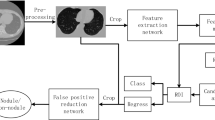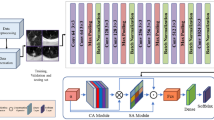Abstract
This paper presents a novel multi-scale attention residual network (MAResNet) for diagnosing patients with pulmonary tuberculosis (PTB) by computed tomography (CT) images. First, a three-dimensional (3D) network structure is applied in MAResNet based on the continuity and correlation of nodal features on different slices of CT images. Secondly, MAResNet incorporates the residual module and Convolutional Block Attention Module (CBAM) to reuse the shallow features of CT images and focus on key features to enhance the feature distinguishability of images. In addition, multi-scale inputs can increase the global receptive field of the network, extract the location information of PTB, and capture the local details of nodules. The expression ability of both high-level and low-level semantic information in the network can also be enhanced. The proposed MAResNet shows excellent results, with overall 94% accuracy in PTB classification. MAResNet based on 3D CT images can assist doctors make more accurate diagnosis of PTB and alleviate the burden of manual screening. In the experiment, a called Grad-CAM was employed to enhance the class activation mapping (CAM) technique for analyzing the model’s output, which can identify lesions in important parts of the lungs and make transparent decisions.
Graphical abstract













Similar content being viewed by others
References
Willie B, Hakim AJ, Badman SG, Weikum D, Narokobi R, Coy K, Gabuzzi J, Pekon S, Gene S, Amos A, Kupul M, Hou P, Dala NM, Whiley DM, Wapling J, Kaldor JM, Vallely AJ, Kelly-Hanku A (2021) High prevalence of pulmonary tuberculosis among female sex workers, men who have sex with men, and transgender women in Papua New Guinea. Trop Med Health 49(1):4. https://doi.org/10.1186/s41182-020-00293-w
Bhati S, Kumar V, Singh S, Singh J (2020) Synthesis, characterization, antimicrobial, anti-tubercular, antioxidant activities and docking simulations of derivatives of 2-(pyridin-3-yl)-1Hbenzo[ d]imidazole and 1,3,4-oxadiazole analogy. Lett Drug Des Discov 17(8):1047–1059. https://doi.org/10.2174/1570180816666191122105313
Aberle DR, Adams AM, Berg CD, Black WC, Clapp JD, Fagerstrom RM, Gareen IF, Gatsonis C, Marcus PM, Sicks JD (2011) Reduced lung-cancer mortality with low-dose computed tomographic screening. N Engl J Med 365(5):395–409. https://doi.org/10.1056/NEJMoa1102873
World Health Organization (2019) Country profiles for 30 high TB burden countries. https://fctc.who.int/publications/i/item/global-tuberculosis-report-2019. Accessed 20 Jan 2023
Luies L, Preez Id (2020) The echo of pulmonary tuberculosis: mechanisms of clinical symptoms and other disease-induced systemic complications. Clin Microbiol Rev 33(4):10.1128/cmr.00036-00020. https://doi.org/10.1128/cmr.00036-20
Kundu S, Marzan M, Gan SH, Islam MA (2020) Prevalence of antibiotic-resistant pulmonary tuberculosis in bangladesh: a systematic review and meta-analysis. Antibiotics (Basel) 9(10):710. https://doi.org/10.3390/antibiotics9100710
Dangisso MH, Datiko DG, Lindtjørn BA-O Identifying geographical heterogeneity of pulmonary tuberculosis in southern Ethiopia: a method to identify clustering for targeted interventions. (1654-9880 (Electronic)). https://doi.org/10.1080/16549716.2020.1785737
Giacomelli IL, Schuhmacher Neto R, Marchiori E, Pereira M, Hochhegger B (2018) Chest X-ray and chest CT findings in patients diagnosed with pulmonary tuberculosis following solid organ transplantation: a systematic review. J Bras Pneumol 44(2):161–166. https://doi.org/10.1590/s1806-37562017000000459
Wang L, Ding W, Mo Y, Shi D, Zhang S, Zhong L, Wang K, Wang J, Huang C, Zhang S, Ye Z, Shen J, Xing Z (2021) Distinguishing nontuberculous mycobacteria from Mycobacterium tuberculosis lung disease from CT images using a deep learning framework. Eur J Nucl Med Mol Imaging 48(13):4293–4306. https://doi.org/10.1007/s00259-021-05432-x
Xing Z, Ding W, Zhang S, Zhong L, Wang L, Wang J, Wang K, Xie Y, Zhao X, Li N, Ye Z (2020) Machine learning-based differentiation of nontuberculous mycobacteria lung disease and pulmonary tuberculosis using CT images. Biomed Res Int 2020:6287545. https://doi.org/10.1155/2020/6287545
Hrizi O, Gasmi K, Ben Ltaifa I, Alshammari H, Karamti H, Krichen M, Ben Ammar L, Mahmood MA (2022) Tuberculosis disease diagnosis based on an optimized machine learning model. J Healthc Eng 2022:8950243. https://doi.org/10.1155/2022/8950243
Govindarajan S, Swaminathan R (2021) Extreme learning machine based differentiation of pulmonary tuberculosis in chest radiographs using integrated local feature descriptors. Comput Methods Prog Biomed 204:106058. https://doi.org/10.1016/j.cmpb.2021.106058
Hooda R, Sofat S, Kaur S, Mittal A, Meriaudeau F (2017) Deep-learning: a potential method for tuberculosis detection using chest radiography. In: 2017 IEEE International Conference on Signal and Image Processing Applications (ICSIPA), pp 497–502. https://doi.org/10.1109/ICSIPA.2017.8120663
Lakhani P, Sundaram B (2017) Deep learning at chest radiography: automated classification of pulmonary tuberculosis by using convolutional neural networks. Radiology 284(2):574–582. https://doi.org/10.1148/radiol.2017162326
Nam JG, Park S, Hwang EJ, Lee JH, Jin KN, Lim KY, Vu TH, Sohn JH, Hwang S, Goo JM, Park CM (2019) Development and validation of deep learning-based automatic detection algorithm for malignant pulmonary nodules on chest radiographs. Radiology 290(1):218–228. https://doi.org/10.1148/radiol.2018180237
Xie Y, Wu Z, Han X, Wang H, Wu Y, Cui L, Feng J, Zhu Z, Chen Z (2020) Computer-aided system for the detection of multicategory pulmonary tuberculosis in radiographs. J Healthc Eng 2020:9205082. https://doi.org/10.1155/2020/9205082
Ul Abideen Z, Ghafoor M, Munir K, Saqib M, Ullah A, Zia T, Tariq SA, Ahmed G, Zahra A Uncertainty assisted robust tuberculosis identification with Bayesian convolutional neural networks. (2169-3536 (Print)). https://doi.org/10.1109/access.2020.2970023
He JS, Han M, Yu L, Mei C (2020) Lung pattern classification via DCNN. In: 2020 IEEE International Conference on Big Data (Big Data), pp 3737–3743. https://doi.org/10.1109/BigData50022.2020.9378090
Zhang Y-D, Nayak DR, Zhang X, Wang S-H (2020) Diagnosis of secondary pulmonary tuberculosis by an eight-layer improved convolutional neural network with stochastic pooling and hyperparameter optimization. J Ambient Intell Humaniz Comput. https://doi.org/10.1007/s12652-020-02612-9
Wang S-H, Govindaraj V, Gorriz JM, Zhang X, Zhang Y-D (2021) Explainable diagnosis of secondary pulmonary tuberculosis by graph rank-based average pooling neural network. J Ambient Intell Humaniz Comput. https://doi.org/10.1007/s12652-021-02998-0
Lu SY, Wang SH, Zhang X, Zhang YD (2022) TBNet: a context-aware graph network for tuberculosis diagnosis. Comput Methods Prog Biomed 214:106587. https://doi.org/10.1016/j.cmpb.2021.106587
Li L, Huang H, Jin X (2018) AE-CNN classification of pulmonary tuberculosis based on CT images. In: 2018 9th International Conference on Information Technology in Medicine and Education (ITME), pp 39–42. https://doi.org/10.1109/itme.2018.00020
LeCun Y, Bengio Y, Hinton G (2015) Deep learning. Nature 521(7553):436–444. https://doi.org/10.1038/nature14539
Gao XW, James-Reynolds C, Currie E (2020) Analysis of tuberculosis severity levels from CT pulmonary images based on enhanced residual deep learning architecture. Neurocomputing 392:233–244. https://doi.org/10.1016/j.neucom.2018.12.086
He K, Zhang X, Ren S, Sun J (2016) Deep residual learning for image recognition. In: 2016 IEEE Conference on Computer Vision and Pattern Recognition (CVPR)
Woo S, Park J, Lee JY, Kweon IS (2018) CBAM: Convolutional Block Attention Module. European Conference on Computer Vision
Li X, Li X, Liu Q, Sun N, Zhang B, Shi C, Zhang R (2020) Traditional Chinese medicine combined with western medicine for the treatment of secondary pulmonary tuberculosis: a PRISMA-compliant meta-analysis. 99(16):e19567. https://doi.org/10.1097/md.0000000000019567
Li X, Zhou Y, Du P, Lang G, Xu M, Wu W (2020) A deep learning system that generates quantitative CT reports for diagnosing pulmonary Tuberculosis. Appl Intell 51(6):4082–4093. https://doi.org/10.1007/s10489-020-02051-1
Ioffe S, Szegedy C (2015) Batch normalization: accelerating deep network training by reducing internal covariate shift. Int Conf Machine Learn. https://doi.org/10.48550/arXiv.1502.03167
Srivastava N, Hinton G, Krizhevsky A, Sutskever I, Salakhutdinov R (2014) Dropout: a simple way to prevent neural networks from overfitting. J Mach Learn Res 15(1):1929–1958. https://doi.org/10.5555/2627435.2670313
Kingma DP, Ba JJC (2014) Adam: a method for stochastic optimization. abs/1412.6980. https://doi.org/10.48550/arXiv.1412.6980
Zhou B, Khosla A, Lapedriza A, Oliva A, Torralba A (2016) Learning deep features for discriminative localization. In: 2016 IEEE Conference on Computer Vision and Pattern Recognition (CVPR), pp 2921–2929. https://doi.org/10.1109/CVPR.2016.319
Funding
National Natural Science Foundation of China [NO. U20A20224]; tuberculosis classification test based on lung CT images [070909922114]; Science and Technology Program of Tongzhou District of Beijing [grant numbers KJ2022CX089].
Author information
Authors and Affiliations
Corresponding authors
Ethics declarations
Conflict of interest
The authors declare no competing interests.
Additional information
Publisher’s Note
Springer Nature remains neutral with regard to jurisdictional claims in published maps and institutional affiliations.
Rights and permissions
Springer Nature or its licensor (e.g. a society or other partner) holds exclusive rights to this article under a publishing agreement with the author(s) or other rightsholder(s); author self-archiving of the accepted manuscript version of this article is solely governed by the terms of such publishing agreement and applicable law.
About this article
Cite this article
Zhang, S., He, C., Wan, Z. et al. Diagnosis of pulmonary tuberculosis with 3D neural network based on multi-scale attention mechanism. Med Biol Eng Comput 62, 1589–1600 (2024). https://doi.org/10.1007/s11517-024-03022-1
Received:
Accepted:
Published:
Issue Date:
DOI: https://doi.org/10.1007/s11517-024-03022-1




